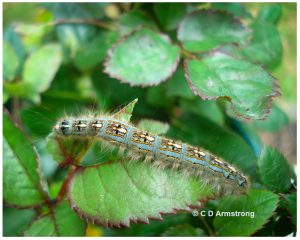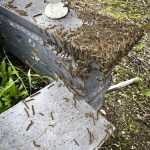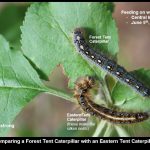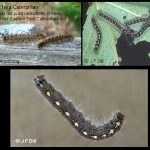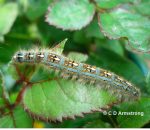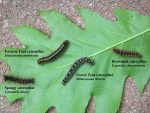Forest Tent Caterpillars
Fully grown Forest Tent Caterpillars have keyhole-like, or shoe print-shaped, whitish spots on each body segment. This fine line of spots runs down the middle of the back for the entire length of the body. On each side there is a blue line, which gives them a bluish appearance. Their favorite hosts are oak, poplar, maple and birch but they can also be found feeding on the leaves of alder, basswood, cherry and willow. The caterpillars do not build nests like the Eastern Tent Caterpillars do, but they do leave mats of silken threads on trees where they travel or rest.
In the past, Forest tent caterpillars have denuded forests in many areas in Maine for up to five years in a row. Trees can usually survive such defoliation, but with reduced growth. Disease, other insects, nutrition, moisture and general poor condition may cause tree mortality in defoliated trees. Higher defoliating populations of forest tent caterpillars typically drop after two years due to natural conditions and diseases. Freezing weather shortly after eggs hatch kills large numbers of caterpillars, and excessively high temperatures later in the spring kills large numbers of adults and reduces the viability of newly laid eggs.
Additional Information:
- Forest and Eastern Tent Caterpillars
- Forest Tent (Malacosoma disstria) (BugGuide.net)
- Forest Tent Caterpillars congregating in preparation of pupation (Van Buren, ME; 6/10/2023)
- Comparing the Eastern Tent Caterpillar (bottom) with a Forest Tent Caterpillar (above). Both were feeding on the leaves of a wild apple tree. The Eastern tent caterpillars make silken nests in the forks of their host trees whereas the forest tent caterpillars make no nests at all, in spite of having “tent” in their name (Etna, ME; 6/5/2015)
-
Forest Tent Caterpillars
(these do NOT build nests)
- A fully-grown Forest Tent Caterpillar (Malacosoma disstria) on a rosebush (Etna, ME; 6/4/2015)
- Comparison of four different caterpillar species in Maine that are sometimes difficult for people to differentiate, and oak is one of the hosts they all have in common (Photographed: central Maine; 6/12/2022) (Eastern Tent caterpillar, Spongy caterpillar, Forest Tent caterpillar, and the Browntail caterpillar)

